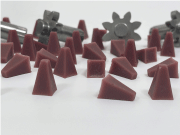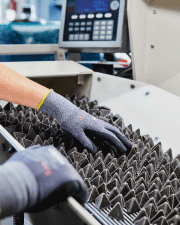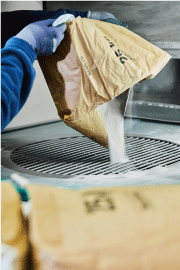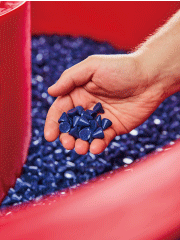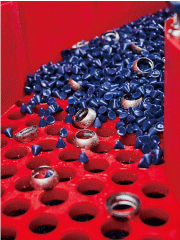In this magazine, a lot has been written about the equipment that is used for mass finishing applications. The finishing media is usually a “step child” that generally receives a lot less attention. But in recent years the focus has definitely shifted more to the media. Frequently, only innovative newly developed media opens the door to new mass finishing applications.
The manufacturers of mass finishing machinery usually offer a wide range of different finishing media that are used for all kinds of applications. However, new finishing processes are developed practically on a daily basis, for which the media “from the catalogue” are not – or no longer - suitable: Often, the customers develop new products, use new materials or apply new manufacturing technologies, which require totally different surface finishing solutions. In this respect, a good example is additive manufacturing.
Under these circumstances, the only solution to a particularly challenging finishing problem can be the development of a brand-new finishing media. But undertaking such a project requires careful consideration of many aspects, including answers to questions such as: When does the development of new media make sense? What are the benefits, and how much does it cost? In short: When do the benefits for the production outweigh the costs for the development?
How is a new media created?
Such media development projects can be quite complicated. For example, one has to decide which is the best-suited material and what geometrical shape the new media should have. Very important is also how well the media fits into the production environment of the user and, last-but-not-least, how much the development and production will cost.
Let me illustrate with an actual case study, how a leading supplier of mass finishing equipment and consumables handles such development projects. Recently, a renowned manufacturer of transmissions needed a new media with a specific geometry for the deburring of toothed gears, where the new media had to precisely follow the shape of the tooth flanks. Because the gears were prone to corrosion, an important technical requirement was that the corrosion protection ingredients in the compound had to be effective on the entire surface area of the workpieces.
None of the standard media available on the market could fulfill these requirements. For this reason, the supplier and customer came jointly to the conclusion that a new media was needed to solve this particular finishing problem. It is worth mentioning that during the subsequent development project, the two companies worked closely together.
The shape has top priority
In this case, the challenge was to not only create a new geometrical shape but to ensure that the compound also worked effectively and consistently despite a potentially low pH value of the process water.
In a first step, the process engineers at the supplier conducted numerous processing trials with the customer’s workpieces in the supplier’s test lab to determine the optimal media shape. They found that a media with a pyramid shape and a square base provided the best contact area for the tooth flanks of the gears.
… the next priority is the material
Subsequently, wear and process stability was analyzed. In this respect the close cooperation between the test lab and chemical lab is always extremely helpful: Shortly before the project was started, the supplier had developed a new range of plastic media. This media creates not only a very smooth surface with a high luster but offers excellent wear characteristics as well.
Another outstanding characteristic of the new media is that it contains a pH buffer that helps prevent a decrease of the pH value in the process water during the mass finishing operation. This is especially advantageous when process water recycling systems are utilized. Such a pH value decrease can occur through the carryover of coolants from drilling, grinding and milling operations into the mass finishing process water. The pH buffer in the media ensures that the compounds are always operating within an optimal pH range. It also means that the acidity of the pH value does not have to be controlled regularly, and no corrective buffer chemicals must be added. Therefore, the dosing of the compound is a lot simpler and requires no special knowledge.
The experience with this newly developed media has also shown that it reduces the effect of the hardness of the process water to a minimum. Moreover, the utilized abrasive minerals are more wear-resistant and can, therefore, be used for a longer period. Overall, the new media contributes significantly to a higher cost-efficiency of the entire mass finishing operation.
Once the geometrical shape had been defined and the material selected, a prototype mold was created for shaping the new media. This is a complicated process, as the mold, with a length of about 2 m, must be milled from a solid slab of steel. The prototype mold was then used for making the production mold needed for volume production.
The results at a glance
This particular media development project was a full success, with excellent surface finishes on the work pieces, short cycle times, long-term stable pH value of the process water irrespective of the water hardness, lower personnel costs for compound dosing and control and, finally, overall lower operating costs.
However, one extremely important aspect should never be forgotten when taking on the development of a new media. Return on investment must always have top priority. In other words: Do the benefits of a new media outweigh its development costs?
My recommendation to all interested readers is to contact the experts at their mass finishing equipment and consumables supplier who are able to undertake such a challenging media development project. Normally such suppliers are constantly developing solutions that are based on a combination of equipment technologies, already existing finishing media and compounds....and of course, knowhow and experience.
Tel. +49.2129.571 207
